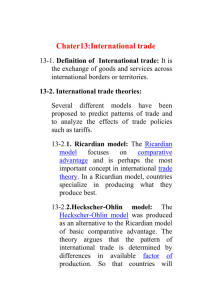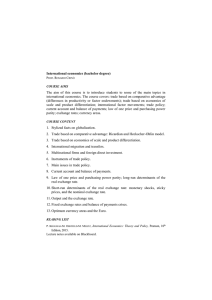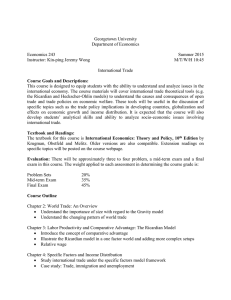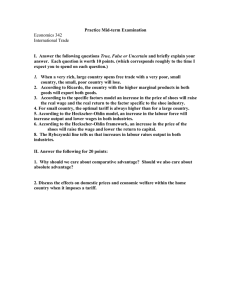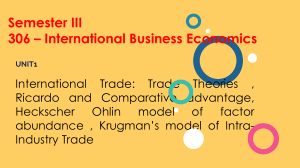ECO 308 RICARDO and HO
advertisement
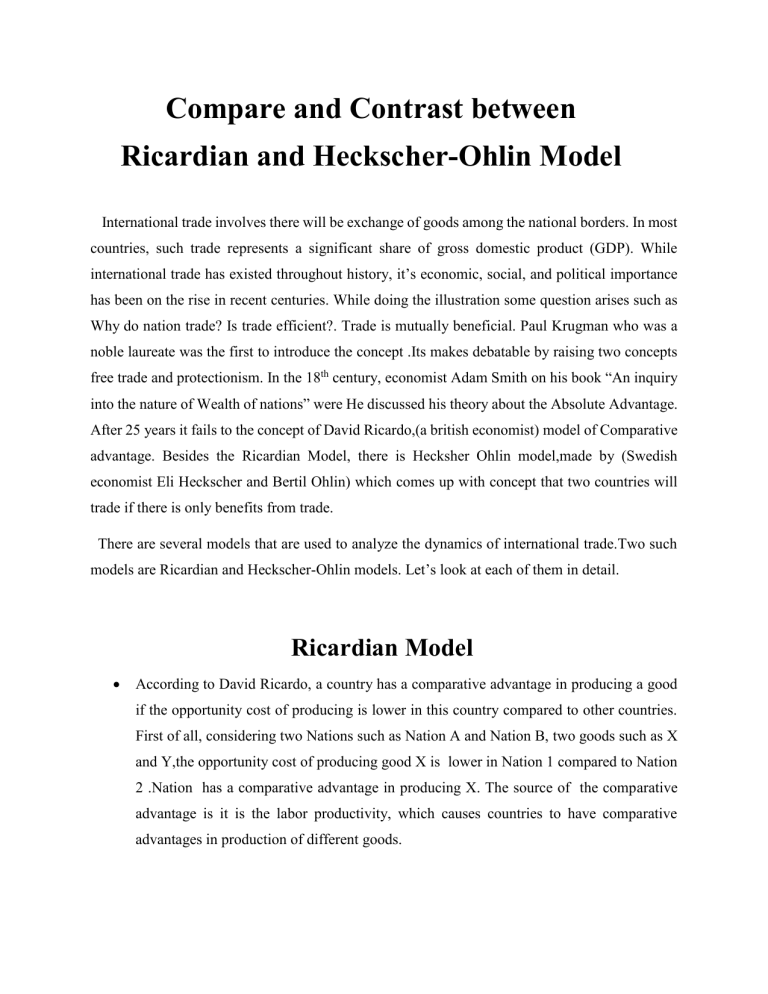
Compare and Contrast between Ricardian and Heckscher-Ohlin Model International trade involves there will be exchange of goods among the national borders. In most countries, such trade represents a significant share of gross domestic product (GDP). While international trade has existed throughout history, it’s economic, social, and political importance has been on the rise in recent centuries. While doing the illustration some question arises such as Why do nation trade? Is trade efficient?. Trade is mutually beneficial. Paul Krugman who was a noble laureate was the first to introduce the concept .Its makes debatable by raising two concepts free trade and protectionism. In the 18th century, economist Adam Smith on his book “An inquiry into the nature of Wealth of nations” were He discussed his theory about the Absolute Advantage. After 25 years it fails to the concept of David Ricardo,(a british economist) model of Comparative advantage. Besides the Ricardian Model, there is Hecksher Ohlin model,made by (Swedish economist Eli Heckscher and Bertil Ohlin) which comes up with concept that two countries will trade if there is only benefits from trade. There are several models that are used to analyze the dynamics of international trade.Two such models are Ricardian and Heckscher-Ohlin models. Let’s look at each of them in detail. Ricardian Model According to David Ricardo, a country has a comparative advantage in producing a good if the opportunity cost of producing is lower in this country compared to other countries. First of all, considering two Nations such as Nation A and Nation B, two goods such as X and Y,the opportunity cost of producing good X is lower in Nation 1 compared to Nation 2 .Nation has a comparative advantage in producing X. The source of the comparative advantage is it is the labor productivity, which causes countries to have comparative advantages in production of different goods. This model is a 2X2X1 model i.e. 2goods, 2countries 1factor of production. The focus is on comparative advantage. The model suggests that the countries specialize in producing goods and services that they can do best. David Ricardo put a much emphasis on the labor theory of value, the fact on that nations must concentrate resources only towards the industries where it has a comparative advantage compared to other nations. The model assumes that there is only one factor of production, that is, labor. The model suggests that the trade occurs between countries because of the differences in labor productivity that occurs because of technological differences. The model applies in the short-run because the technology can change internationally over time PPF is a downward sloping straight line, because there is only one factor of production called labour.[no factor of substitution].In the graph on the vertical axis Home wine production is shown and on the horizontal axis Home cheese production is shown. L/alw is the relative labour requirement in wine production in Home and L/alc is the relative labor requirement in the cheese production in Home. The RD and RD’ curves shows that the demand for cheese and to wine is a decreasing function of the price of cheese relativeto that wine,while the RS curve shows that the supply of cheese relative to wine is an increasing function of the same relative price. Heckscher-Ohlin Model Unlike Ricardian Model, the model suggested by Heckscher-Ohlin assumes that there are two factors of production, namely, labor and capital. One country has comparative advantage over the other because of the differences in relative amounts of each factor. The model suggests that countries should produce and export goods using the resources that they have in abundance. Similarly, the countries should import goods that require resources that they have in short supply. Note that this model differs from the comparative advantage theory that focuses on the efficiency of the production process. Because the country produces goods based on the resources that they have in abundance, it will be cheapest to produce these goods. Very broadly, countries that have more capital will specialize in capital-intensive goods and countries that countries with more labor will specialize in labor-intensive goods. These countries will trade these goods with each other. This model assumes that labor and capital can flow freely between sectors and that the amount of these two factors differs among countries. The model also assumes that in the long-run countries have same technology. The Heckscher-Ohlin model suggests that there will be a redistribution of wealth between the labor and owners of capital. Fig: Resources and Production possibilities In each sector ,the ratio of the labor to capital used in production depends on the cost of capital w/r. The curve FF shows the labor-capital ratio choices in food production, the curve CC shows the corresponding choices in cloth production. Because cloth production is labor intensive, while food production is capital intensive, there is a one to one relationship among them. The comparison of Ricardian and H-O model 1. No difference among internal and international trade According to the Classical economists, there is a need for a separate theory of international trade because of the differences between internal and international trade. But according to Ohlin, there is no need for a separate theory of international trade, as fundamental principle of both is same. 2. More variables As against Ricardian Theory which is based on two countries, two commodities and one factor. alcQc + alwQw < L Ohlin's Modern theory incorporates two countries two commodities and two factors. 3. Comparative cost theory According to the classical theory, the principle of comparative costs is a special feature of international trade. According to Ohlin, the principle of comparative cost is applicable to all trade; whether internal or international. 4. Cost difference is expressed in terms of money Superiority of H.O. theory lies in the fact that it calculates the cost differences in terms of money. Ricardo explains the difference in terms of labour theory of value of which is full of defects and impracticable. Trade which involves exchange of goods and services has been carried in terms of money. H.O. theory renders the cause of the trade easy to understand. 5. Supply of factors of production considered The main cause of the international trade is the difference in factor supplies between the countries. Each country differs in factor endowments i.e. in their abundance or scarcity. Difference in supply, given the demand, brings the difference in cost of factor and finally, the difference in commodity prices. In Ricardian theory, difference in factor (labour) efficiency is recognized but difference in factor supply is ignored. H.O. theory, therefore provides a better explanation of price difference of factors through the difference is their supplies. 6. Contribution to positive economies Ricardian theory which no doubt explains the reason for internal trade is more concerned with the benefits of trade. For classical economists, the welfare aspect of trade is more important. Ohlin has adapted a positive approach in explaining the cause of international trade. His main concern was to find out the cause of trade and not so much of its welfare aspect. Therefore, it is pointed out that Ohlin's analysis has contributed to positive economic analysis. Conclusion - Ohlin's Theory Vs Ricardian Theory In the classical analysis, difference in the cost ratios between countries are due to the difference in the skill and efficiency of labour. It implies that there will be no trade in future if the two countries have mastered each other's technique and labour becomes equally efficient in both. But Ohlin's theory asserts that trade will never end even if knowledge travels freely between the countries and the best techniques of production are always known to both countries. This is because, the modern theory states that the relative differences in factor endowments are the relative causes for the differences in the prices of commodities. Thus the modern theory is an improvement over the classical theory.
